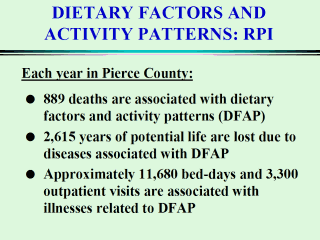| front |1 |2 |3 |4 |5 |6 |7 |8 |9 |10 |11 |12 |13 |14 |15 |16 |17 |18 |19 |20 |21 |22 |23 |24 |25 |26 |27 |28 |29 |30 |31 |32 |33 |34 |35 |36 |37 |38 |39 |review |
 |
McGinnis (1993)*
reported the following findings
pertaining to the DFAP-attributable risk factors: "… studies have
associated dietary factors of sedentary lifestyles with 22% to 30% of
cardiovascular deaths, 20% to 60% of fatal cancers, and 50% to 80% of
diabetes mellitus cases, including 30% of diabetes deaths." These
estimates (denoted as DAF_MINk and DAF_MAXk)
along with corresponding mortality figures obtained from VISTA database were
used for estimating deaths and YPLL attributable to DFAP in Pierce County.
Average attributable risk factors were defined as DAF_AVk
= (DAF_MINk+DAF_MAXk )/2. Here is an example. The numbers of deaths and YPLL due to heart disease were found to be equal to 1,299 and 2,806, respectively. The calculation suggests that on average (22% + 30%)/2 = 26% of deaths due to heart diseases were associated with DFAP. Therefore, the estimated average numbers of deaths and YPLL due to heart diseases would be equal to 1,299*0.26 = 338 deaths and 2,806*0.26 = 730 YPLL, respectively. To estimate the number of hospital bed-days Ak pertaining to disease k and related to DFAP, it was assumed that Ak is proportional to BDAYSk (the total number of bed-days pertaining to disease k calculated from CHARS data base), with proportionality coefficient DAF_AVk: Ak = DAF_AVk*BDAYSk . The number of visits Bk to the outpatient hospital that pertained to disease k and related to DFAP was estimated in a similar way as it was in the Tobacco section. The difference was in choosing the proportionality coefficient: DAF_AVk was used instead of SAFk. * McGinnis GM, Foege WH (1993) Actual causes of death in the United States. JAMA Vol. 270, No 18, November 10. |
| front |1 |2 |3 |4 |5 |6 |7 |8 |9 |10 |11 |12 |13 |14 |15 |16 |17 |18 |19 |20 |21 |22 |23 |24 |25 |26 |27 |28 |29 |30 |31 |32 |33 |34 |35 |36 |37 |38 |39 |review |